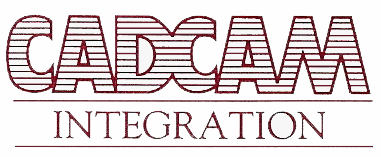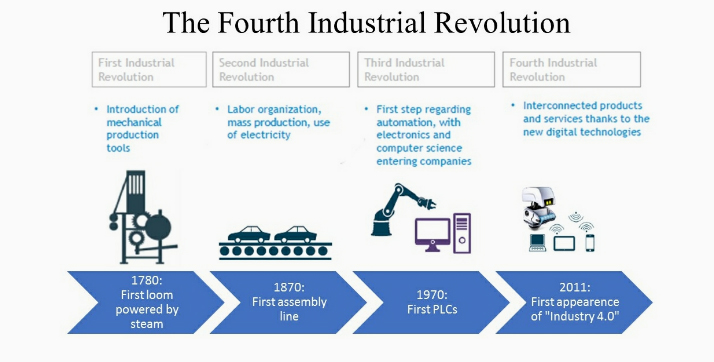
The Automation Stack Today and into the Future (ShopFloorManager's place in the 3.0 Industrial Revolution)

The industrial internet of things (IIoT) refers to interconnected sensors, instruments, and other devices networked together with computers' industrial applications, including manufacturing and energy management.
This connectivity allows for data collection, exchange, and analysis, potentially facilitating improvements in productivity and efficiency as well as other economic benefits. The IIoT is an evolution of a distributed control system (DCS) that allows for a higher degree of automation by using cloud computing to refine and optimize the process controls.
The IIoT is enabled by technologies such as cybersecurity, cloud computing, edge computing, mobile technologies, machine-to-machine, 3D printing, advanced robotics, big data, internet of things, RFID technology, and cognitive computing. Five of the most important ones are described below:
Cyber-physical systems (CPS): the basic technology platform for IoT and IIoT and therefore the main enabler to connect physical machines that were previously disconnected. CPS integrates the dynamics of the physical process with those of software and communication, providing abstractions and modeling, design, and analysis techniques.
Cloud computing: With cloud computing IT services and resources can be uploaded to and retrieved from the Internet as opposed to direct connection to a server. Files can be kept on cloud-based storage systems rather than on local storage devices.
Edge computing: A distributed computing paradigm which brings computer data storage closer to the location where it is needed. In contrast to cloud computing, edge computing refers to decentralized data processing at the edge of the network. The industrial internet requires more of an edge-plus-cloud architecture rather than one based on purely centralized cloud; in order to transform productivity, products and services in the industrial world.
Big data analytics: Big data analytics is the process of examining large and varied data sets, or big data.
Machine learning is a core part of AI, allowing software to more accurately predict outcomes without explicitly being programmed. It is also possible to combine artificial intelligence with edge computing in order to provide industrial edge intelligence solutions.
Get to Know IIoT Step 1 The Five Layer Model
Get to Know IIoT Step 2 What is IIoT
Get to Know IIoT Step 3 What is an IIoT Protocol?
Get to Know IIoT Step 4 What is MQTT? Why does it matter?
Get to Know IIoT Step 5 The Industry 4.0 MINDSET!!
Get to Know IIoT Step 6 IIoT vs Digital Transformation vs Industry 4.0. What are their Relationships?
Get to Know IIoT Step 7 Industry 4.0 + IIoT + Digital Transformation... HOW DO THEY WORK TOGETHER?
What is Machine Learning & AI? Machine Learning & AI
The Digital Transformation
After the advent of the steam engine in 1760, steam was used to power everything from agriculture to textile manufacturing. This caused the First Industrial Revolution and the age of mechanical production.
At the end of the 19th century came the arrival of electricity, new modes of labor organization, and mass production, which started the Second Industrial Revolution.
In the second half of the 20th century, the development of semiconductors and the introduction of electronic controllers produced the beginning of the automation era and the Third Industrial Revolution.
In the Hannover exhibition of 2011, Henning Kagermann, Wolf-Dieter Lukas, and Wolfgang Wahlster coined the term Industry 4.0 for the project of renewing the German manufacturing system using the capabilities of the latest digital technology:

Stages of the Industrial Revolution throughout history Industry 4.0 is expected to be able to do the following: Connect or merge production with information and communication technology Merge customer data with machine data Harness the capability of machines communicating with machines Manage production autonomously in a flexible, efficient, and resource-saving manner
The IoT is almost, by definition, the key for further development of the manufacturing industry by including technologies such as big data analytics, the cloud, robotics, and most importantly, the integration and convergence between IT and OT.
Generally speaking, the term I-IoT refers to the industrial subset of the IoT. The I-IoT, like the IoT, is not just a specific new technology, but instead refers to the whole chain of value of a product.
Similarly, the I-IoT impacts all sectors of the industrial world by significantly modifying the processes at each stage of the life cycle of a product, including how it is designed, made, delivered, sold, and maintained.
Like the IoT, we are just at the beginning of the I-IoT journey. The I-IoT is expected to generate so much business value and have such a deep impact on human society that it is leading the Fourth Industrial Revolution.
Credits: Veneri, Giacomo; Capasso, Antonio. Hands-On Industrial Internet of Things: Create a powerful Industrial IoT infrastructure using Industry 4.0
Use OEE to keep your Equipment Effectiveness up to International Standards
Overall equipment effectiveness, or OEE, is a metric used to measure how productive your manufacturing operations are. OEE compares how much quality product a piece of machinery produces in a certain period and how much you need to produce in that time.
Calculating OEE produces a number that represents your machine's combined ranking in six categories. These categories, called the six big losses, are:
Why is overall equipment effectiveness important?
This metric can help you determine how much of your production time is being used effectively and where you can make alterations to increase your production times. It can also help you measure your progress toward operational improvement. Here are other some reasons why calculating OEE helps improve your business:
Credits: -Indeed.com- What Is Overall Equipment Effectiveness? Definition and Example
Book on OEE OEE for the Production Team
To Learn More About OEE
Take a free course (Open Enrollment) at MIT OEE
Capturing real-time Critical Data
Edge computing is a distributed computing paradigm that brings computation and data storage closer to the sources of data. This is expected to improve response times and save bandwidth. It is an architecture rather than a specific technology. It is a topology- and location-sensitive form of distributed computing.
The origins of edge computing lie in content distributed networks that were created in the late 1990s to serve web and video content from edge servers that were deployed close to users. In the early 2000s, these networks evolved to host applications and application components at the edge servers, resulting in the first commercial edge computing services that hosted applications such as dealer locators, shopping carts, real-time data aggregators, and ad insertion engines.
Internet of things (IoT) is an example of edge computing. A common misconception is that edge and IoT are synonymous.
Credits: -Wikipedia- Edge Computing
Managing and distributing all IIot Data from it's sources to it's destinations
The MQTT broker is a piece of software running on a computer (running on-premises or in the cloud), and could be self-built or hosted by a third party. It is available in both open source and proprietary implementations.
The broker acts as a post office. MQTT clients don't use a direct connection address of the intended recipient, but use the subject line called "Topic". Anyone who subscribes receives a copy of all messages for that topic. Multiple clients can subscribe to a topic from a single broker (one to many capability), and a single client can register subscriptions to topics with multiple brokers (many to one).
Each client can both produce and receive data by both publishing and subscribing, i.e. the devices can publish sensor data and still be able to receive the configuration information or control commands (MQTT is a bi-directional communication protocol). This helps in both sharing data, managing and controlling devices. A client can not broadcast the same data to a range of topics, and must publish multiple messages to the broker, each with a single topic given.
With MQTT broker architecture, the client devices and server application become decoupled. In this way, the clients are kept unaware of each other's information. MQTT, if configured, can use TLS encryption with certificate, username and password protected connections. Optionally, the connection may require certification, in the form of a certificate file that a client provides and must match with the server's copy.
In case of failure, broker software and clients can automatically handover to Redundant/automatic backup broker. Backup brokers can also be set up to share the load of clients across multiple servers onsite, in the cloud, or a combination of these.
The broker can support both standard MQTT and MQTT for compliant specifications such as Sparkplug.[20] This can be done with same server, at the same time and with the same levels of security.
The broker keeps track of all the session's information as the device goes on and off, in a function called "persistent sessions". In this state, a broker will store both connection info for each client, topics each client has subscribed to, and any messages for a topic with a QoS of 1 or 2.[21]
The main advantages of MQTT broker are:
Credits: -Wikipedia- MQTT
When there is to much Data for Humans
Machine learning (ML) is a field of inquiry devoted to understanding and building methods that 'learn', that is, methods that leverage data to improve performance on some set of tasks. It is seen as a part of artificial intelligence. Machine learning algorithms build a model based on sample data, known as training data, in order to make predictions or decisions without being explicitly programmed to do so. Machine learning algorithms are used in a wide variety of applications, such as in medicine, email filtering, speech recognition, agriculture, and computer vision, where it is difficult or unfeasible to develop conventional algorithms to perform the needed tasks.
Credits: -Wikipedia- Machine Learning
Quickly Discerning Patterns From ML and then make Intelligent Decisions
Artificial intelligence (AI) is intelligence - perceiving, synthesizing, and inferring information - demonstrated by machines, as opposed to intelligence displayed by animals and humans. Example tasks in which this is done include speech recognition, computer vision, translation between (natural) languages, as well as other mappings of inputs. OED (OUP) defines artificial intelligence as: the theory and development of computer systems able to perform tasks that normally require human intelligence, such as visual perception, speech recognition, decision-making, and translation between languages.
AI applications include advanced web search engines (e.g., Google), recommendation systems (used by YouTube, Amazon and Netflix), understanding human speech (such as Siri and Alexa), self-driving cars (e.g., Tesla), automated decision-making and competing at the highest level in strategic game systems (such as chess and Go). As machines become increasingly capable, tasks considered to require "intelligence" are often removed from the definition of AI, a phenomenon known as the AI effect. For instance, optical character recognition is frequently excluded from things considered to be AI, having become a routine technology.
Credits: -Wikipedia- Artificial intelligence